The villages Agüimes and Santa Brigida are both worth a day trip – albeit for different reasons. What those two villages in the central mountains of Gran Canaria have in common, though, is their enchanting beauty.

From Gran Canaria’s capital Las Palmas, they are some of the easiest day trips you can go on by public bus.
Climate Change – Literally
“So the forecast was right – it is raining”. Yes, I’m stating the obvious. Mimi frowns: “I would have been grateful if you had informed me of this little fun fact beforehand”. She pulls her huge shawl tight. What is her bickering about? I’m wearing shorts and a short-sleeved T-shirt and I’m really very, very cold.

While at our base camp on the beach of Las Palmas it was quite warm this morning, the higher the bus brought us, the colder it got. And now here at Santa Brígida, I’m really suffering. It’s cold and big dark-grey clouds are encasing the mountaintops. This is what you get from being on an island that’s referred to as a micro-continent: You experience all four seasons within one hour.
Santa Brígida
As a matter of fact, I fell victim to the Canary’s climatic phenomenon called panza de burro, which translates to the donkey’s belly. It is an accumulation of low-lying clouds. These block the sun out which results in a thermal sensation of cool and high humidity. Santa Brígida is infamous for that.
The town is located 600 meters above sea level and surrounded by lush mountains known for their beautiful palm trees. There was an old Canarian settlement in this spot called Sataute which translates to palm plantation in the native Canarian language.
After the conquest, the Castilians transformed those palm forests into gardens and fields.

In 1599, the municipality experienced one of its most outstanding historic events: The defeat of the troops of the Dutch pirate Van der Does. In memory of the said event, the town’s coat of arms contains a gold ribbon with the words For Spain and for Faith, we defeated the Dutch.
A Land Before Our Time
At the end of the 19th century, Santa Brígida was actually one of the earliest tourist places in the Canary Islands. The presence of British visitors and residents has left a mark on the local architecture, especially on some Victorian-style hotels.
Today, most visitors come to Santa Brígida to hike the Caldera de Bandama which is located 7 kilometers east of the town.
On its north side is the Cueva de los Canarios which the Canarians used as a granary. Inside, Libo-Berber inscriptions as well as vessels were found. They are now on display at the Museo Canario in Las Palmas.
Further traces of the native Canarians were also found in the valley of La Angostura and Las Meleguinas. There are caves dug into the rock which the Canarios used as dwellings and for storage.
Close to La Angostura is also the archaeological site of El Tejar. An old brick factory from the 16th century gave the place its name. A wall of uncut stones was found at this site, indicating the former existence of an aboriginal home or burial site. Numerous clay and ceramic objects, as well as carvings, were found here, too.

If you want to learn more about the native Canarians and their culture before the Spanish conquest, I highly recommend visiting the Museum and Archeological Site Cueva Pintada in Gáldar.
A Quick Tour
Santa Brígida is a relatively small town with not that much to see. Getting there from Las Palmas by car takes only about 20 minutes. And even by public bus, the trip is less than an hour. Unless you intend to go also for a hike in the surrounding mountains, you can visit the town easily on a half-day tour.
Since I was freezing terribly, I was quite grateful that we could explore the town center in just a couple of hours. And that included even a warming break at a cozy bar.

As you get to Santa Brígida, there’s the Casa Museo del Vino right next to the bus stop. Here, you learn about wine production and can sample their products, obviously. They also run a restaurant specializing in Canarian food.
In an over 200-year-old historic building are the exhibition spaces, a multipurpose room, as well as a shop where you can purchase the finest wines.

Also, you can enjoy their terrace and a large garden from where you have a spectacular view of Santa Brígida’s palm grove.
Knowledgeable staff organizes the wine tasting that includes also regional artisan cheese.
The Casa del Vino has very unregular opening hours – I suggest you check their facebook-page where you’ll also find further contact details
Sceneries
Right behind the Casa Museo del Vino is the agricultural estate El Galeón. This typical Canarian agricultural terrain combines traditional crops, livestock, and a palm grove. It can be visited every day free of charge.

The farm is surrounded by palm trees, wild olives, mastic trees, morning glory, and other kinds of trees and shrubs.

We saw some patches’n’plots where fruits and vegetables are grown. Also, there were a couple of donkeys.

However, the Finca also offers fantastic views of the surrounding hills and mountains as well as the Barranco del Colegio. You have a panoramic view all the way to the Atlantic coast – even on a cloudy day.
Historic Center of Santa Brígida
The majority of Santa Brígida’s historic buildings are found in the vicinity of the Parish Church of Santa Brígida.
This house of worship was built in a neo-Gothic style in the spot where the village’s first hermitage was founded in 1522. The church burned down in a fire in 1897. Today, only the tower remains from the original structures. The church-building was constructed in the first decades of the 20th century.

The adjacent square Plaza de León y Castillo opens to the Barranco de Santa Brígida and offers just incredible views.

From the Plaza de León y Castillo, the Calle Real leads southwards. Since the town’s commerce took place on this stretch, there are many stately buildings, made from the typical stonework.
At the end of the street where the Calle Real joins the main road Calle Calvo Sotelo is the Real Casino De Santa Brígida. It was built in a neoclassical style with large windows and an iron balcony and opened in 1926. It has been a popular meeting place for the entire community.
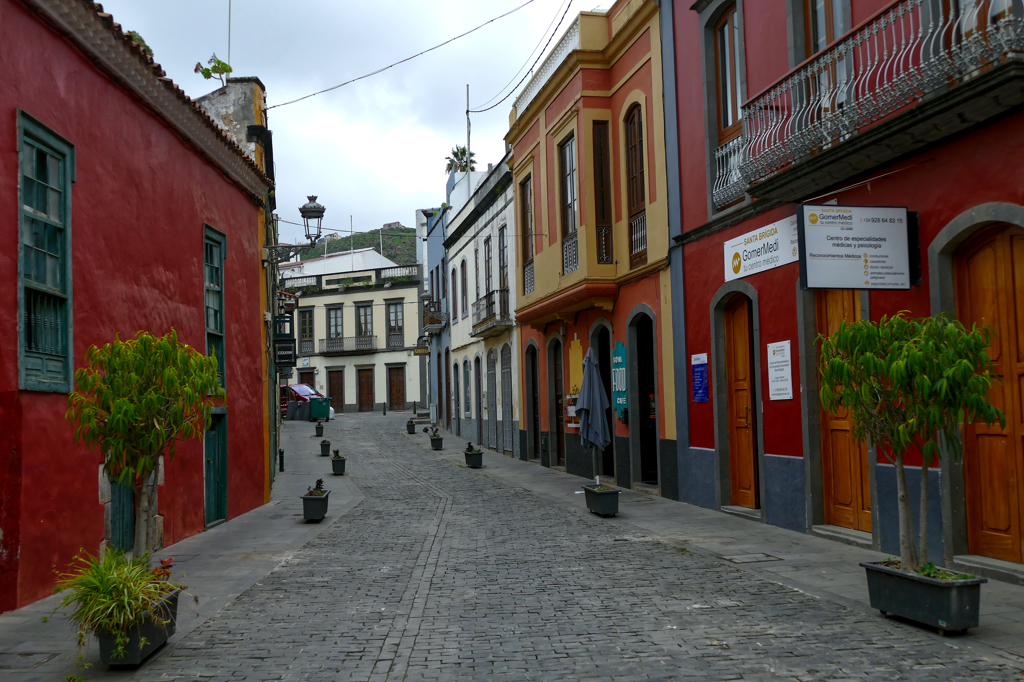
However, I think this is a good time to make clear that in this sense, a casino is not a place where you lose all the spending money you had saved up for your trip. No, just like the casino that I’ve introduced in my post on Gáldar, a casino is basically a culture’n’community center.
Walking Into the Past
Next to the Casino, there is another representative property, known as Fonda Melián. In the past, it was a resting place for travelers on their way to the peaks of the island as well as for those who came back down, obviously.

The third most outstanding building in the neighborhood of La Alcantarilla, the historic old town, is the Heredad de Aguas. Designed by the architect Fernando Navarro Navarro in a post-neoclassical style in 1913, this is where the distribution of water to the different farms around the municipality took place. Work shifts on the farms took place according to the time shown on the façade’s huge clock.

My absolutely favorite structure in Santa Brígida is El Calvario. El Calvario is a stonework construction with three pinnacles. Each of them has a cross on top. In the center is a niche housing an image of the Passion of Jesus Christ. In the past, it marked the border of the urban area. Also, it is a reference point where the Holy Week procession ended and from where a burial procession departed.
Out Of Santa Brígida
The Parque Natural de Bandama is not only an outstanding archeological site. It is also an area of great geological and botanical interest and a wonderful place for hikers.
The Bandama Natural Monument is an eroded volcanic crater located 574 meters above sea level. From the crater, large amounts of ash were ejected. This ash covers an ample area, however, it is almost completely overgrown with meadows, clover, olive trees, and palm trees.

About three kilometers west of Santa Brígida is the so-called Drago de Pino Santo in the Barranco Alonso. Although there is a significant number of centuries-old dragon trees of considerable size and unique beauty in the area, this is the most famous one. Its trunk has a diameter of 3.5 meters and grows from the cliff below the edge. It is basically clinging to the steep face at a height of 17 meters.
How To Get There
Getting to Santa Brígida from Las Palmas is very easy and fast. However, while by car, it takes under half an hour, prepare for double if you opt for the public bus. Bus #301 leaves from Estación Santa Catalina and bus #311 from Estación San Telmo.
To get from Santa Brígida to Bandama, you have to take bus #301 to Cruze de Bandama and continue from there by bus #311 to Bandama. The latter is actually going back to Santa Brígida on a different road, don’t let that confuse you.
If you want to go to the Drago de Pino Santo, take bus #318 at the stop Ambulatorio towards Pino Santo Bajo and get off at Hoya Chiquita. This stop is right next to the Drago.
For general information and schedules, you can check out the website of Global, Gran Canaria’s interurban bus company. Global’s blue buses are connecting practically all towns and villages on the island, however, often via Las Palmas. To get your most convenient connection, you can simply type your location and desired destination into google maps.
By the way, locals call all buses la guagua, not only those of the eponymous bus company in the capital Las Palmas de Gran Canaria.
Where To Stay
As I pointed out above, Santa Brígida looks back at a long history of tourism. Therefore, especially on the outskirts alongside the big roads towards Las Palmas and Vega de San Mateo are some truly posh lodging options. Being a 4-star hotel, the Hotel Escuela Santa Brígida* offers comfort at an amazing price. It’s a hotel where future chefs and service people are learning their trade, hence, they give it their best, obviously. However, on this map you’ll find more convenient lodging options*:
What To Eat
In Santa Brígida, as well as in all other towns’n’village on the island, traditional Canarian cuisine plays the leading role. An exception is the tourist area in the south where we even saw signed advertising for Finnish restaurants. Anyway, in rural areas, grilled meats, stews, and excellent broths are made from the products of the surrounding fields and farms.

We took a very pleasant break at the Picoteo Café El Despacho on Calle Real as our local friend Sandra took us there. Since it was before noon, we just sampled some of their artisan cheeses and tried only one glass of the fantastic, award-winning local red wine.
Next time, we’ll be back for more – wine and food, obviously.
Map
This map should help you to find all the wonderful spots in Santa Brígida. Clicking on the slider symbol at the top left or the full-screen icon at the top right will display the whole map including the legend.
A Long And Winding Road
“This is the road on which the ambulance took me to the hospital”, I muse in a low, sad voice, rather to myself. I’ve been to Agüimes a couple of months ago and had a terrible accident after only 23 hours. Then, I spent another week at the hospital in Las Palmas, and that had been it for my vacation. You can read the whole sad story in my post Break a Leg – My Bumpy First Encounter With Gran Canaria.
So now that we are going up the hilly road towards Agüimes, I’m getting a bit sappy. “But they didn’t stop that often”, Mimi answers jokingly – to cheer me up and also to encourage herself by saying something goofy as she feels motion sick again. After all, the way to Agüimes is very curvy and the bus does stop at what feels like every street corner.

But as always on the day trips during our stay in Gran Canaria, we make it to the final destination in time and as we get off the bus in the center of Agüimes she is so amazed by the village’s beauty that she immediately forgets her misery.
Agüimes
The municipality of Agüimes is located in the mountains southeast of Las Palmas. It was actually one of the first places where the Castilian defeaters settled after the conquest in 1491. The town was established under episcopal authority by the order of the Catholic Kings. In return, the Church supported the Castilian invaders during the conquest.
Thanks to the watercourses coming from the Guayadeque ravine basin, the land around Agüimes is fertile. It was here where the first sugar cane plantations were installed. Today, however, tomatoes and cucumbers are grown in the area. Most of them are being exported.
However, in the 17th century, migration from Spain to the Americas began. As inhabitants of Agüimes left for Cuba, Puerto Rico, and other American countries in search of prosperity, many of them made a fortune. However, some of them made it back home to Gran Canaria, eventually.
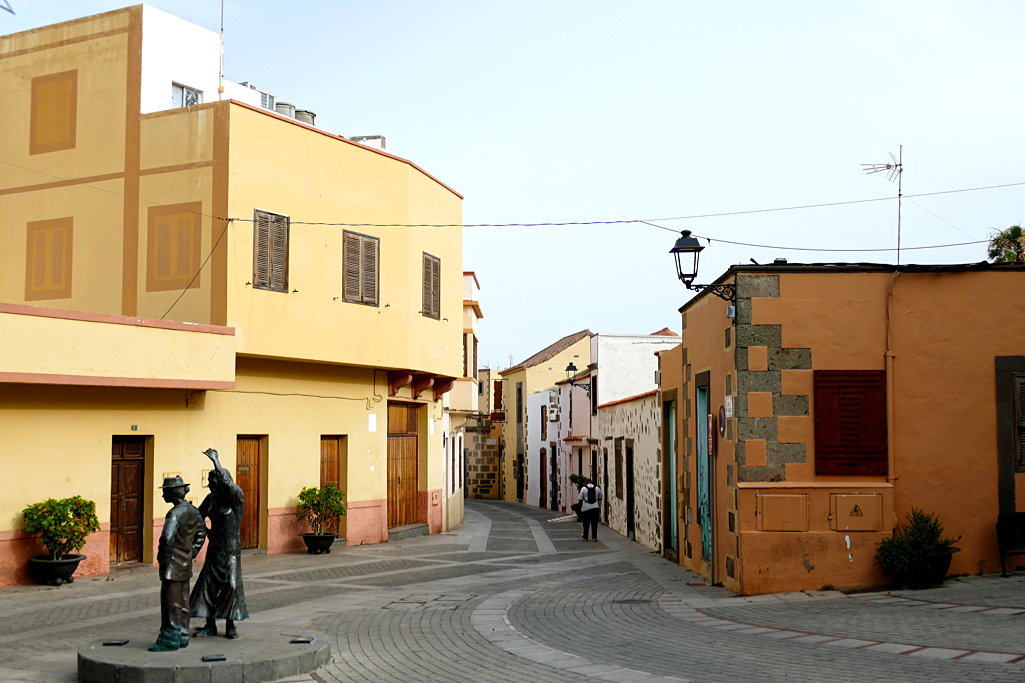
Agüimes is also a venue of various festivities’n’festivals honoring for instance the town’s patron saint San Sebastián and the Virgen del Rosario. Another highly significant event is the yearly carnival. Actually, the Carnaval de Agüimes is far more than just a huge brouhaha. In Spain’s politically dark years, it was a symbol of subversiveness and resistance.
A Quick Tour
As I pointed out a couple of times on my blog, I don’t believe in comparing’n’categorizing. People, places, and many aspects of life are different – which doesn’t make them either superior or inferior, neither better nor worse. This being said: Agüimes is the most beautiful settlement in all of Gran Canaria.
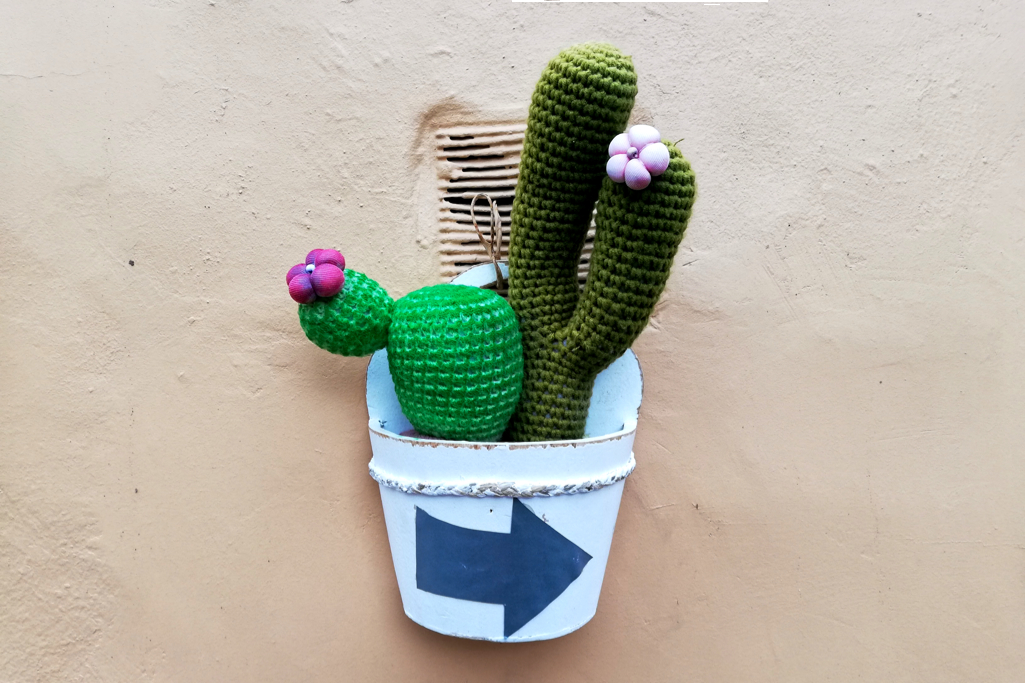
Agüimes is like a big art installation. Every corner of the enchanting old town seems to have been sculpted by an artist’s hand. The townscape is a marvelous composition of tradition and history. The enchanting labyrinth of streets, alleys, squares, and passageways is just breathtakingly alluring.
In many spots, sculptures made of wrought and cast iron are greeting the visitor. And while other towns’n’cities tend to celebrate Royalties and other grand men, Agüimes honors its humble folks from the neighborhood.

Strolling through the streets you will be greeted by a shoeshine boy, by a woman milking a goat, by carnivalists, musicians, and many other iron inhabitants. Also, there are local farm animals like a donkey and a camel. And although camels may no longer trek across the cobblestones, their echoes have not faded from the city’s memory and their former shelters are now housing charming restaurants.
Writing on the Wall
As you might know from former posts like Best Street Art in Palma de Mallorca, Best Street Art in Málaga, and Best Street Art in Valencia, I’m a huge fan of street art. Street art is not only decoration but also creates identification with neighborhoods and is actually an important asset when it comes to the improvement of quality of life.
After a major street art hype, now poetry in public spaces is on the rising. One of the earliest movements is probably London’s Poems on the Underground initiative which was launched way back in 1986.

However, poetry in public places is by far not reserved for the big hip metropoles. Right here in enchanting little Agüimes, walls are praising the town’s beauty. The longest and probably most famous one is El Romance de Agüimes by Joaquin Artiles, nevertheless, you’ll spot others as you walk those lovely streets.
Plaza de Los Moros
As a matter of fact, there aren’t that many designated tourist attractions in Agüimes – as the town as such is an overwhelmingly beautiful draw. However, one of those classic points of interest would be the history museum. Here, the visitors are introduced to the last five centuries of the history of the region, beginning with the establishment as an episcopal authority after the Castilian conquest until the middle of the 20th century.

The museum is housed in a mansion that belonged to the Verdugo family. Since Manuel José Verdugo y Albiturría was the last Bishop of Agüimes, the manor is also known as the Episcopal Palace.

Interestingly, many residents of Agüimes have generously contributed personal items to the exhibitions. This way, they are thoroughly preserved and cherished by all visitors.
The museum can be visited from Tuesday to Saturday between 9 a.m. to 5 p.m. for an entrance fee of 3 €uros.
Plaza del Rosario
Almost every settlement in Europe has a central square and Agüimes is no exception to this rule. Obviously, it is the most prominent spot in town. Under the big lush trees are benches where you can relax and watch time’n’people passing by. Some of these folks are not made of flesh’n’blood but sculpted from iron by local artists. Also, if you get hungry or need to quench your thirst, there are a couple of restaurants and bars serving the best the region around Agüimes has to offer.

The square’s most significant structure is the Iglesia de San Sebastián, obviously. This church was built in three phases mainly in the 19th century and is one of the most exquisite examples of neo-classical Canarian architecture on the island. Nevertheless, it also shows certain Gothic and Baroque elements.
The church is open from 9.30 a. m. to 1 p. m. and then again in the evening from 6 p.m. to 8.30 p.m.
Dog Years
Once you’re at the Plaza del Rosario, make sure to walk down the Calle Alejandro Hidalgo towards Plaza del Auditorio. Although the square, as well as the convention hall, are not very alluring, the adjacent alleys definitely are.

Especially the picturesque Callejón La Luz is one of Agüimes’ gems. Here you’ll also get to see two sculptures of the iconic Dogos Canarios. Supposedly, they are a reminder that the archipelago’s name stems from the Latin Canariae Insulae, hence, the island of dogs. The Dogo Canario is a dog breed that has been known in Spain since the end of the Middle Ages. As a matter of fact, these Spanish mastiffs were carried by the conquistadors as war dogs for the conquest of South America. However, many of these dogs were left behind in the Canary Islands. Today, they are mostly used as watchdogs.
Every House A Landmark
As I mentioned above: The biggest treasure is the town itself. Every street is just so scenic and each house is an alluring piece of art. There is beauty and there are reminders of the rich cultural heritage at every corner.

The artistically crafted doors, windows, and decorative details of the buildings that were once commissioned by the wealthy families of Agüimes are proving the skill of the craftsmen and builders.

One of the masterpieces is the Casa de Los Camellos. More than 300 years ago, it used to be a barn and a stable for camels. Actually, there’s still a camel just around the corner from the main entrance – albeit, it’s cast from iron. Today, this beautiful structure is a lovely guest house. I’m introducing it in the Where To Stay section below.
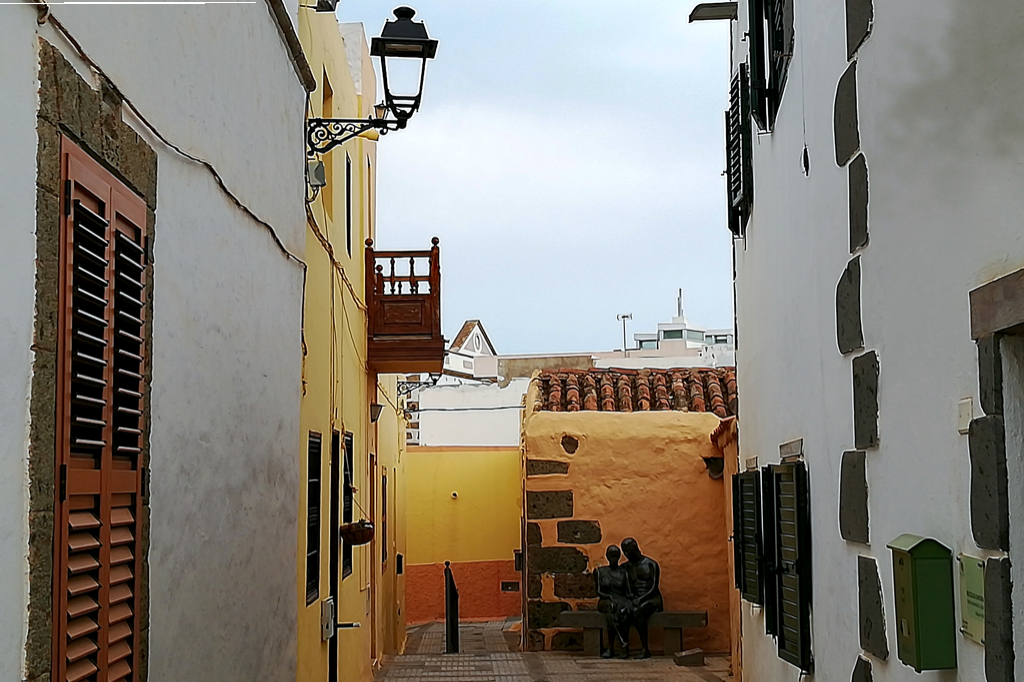
Out Of Agüimes
Yes, Agüimes is a treasure. Yet, the town is also quite small, and if you walk up and down the lovely alleys and cobblestone streets, you’ve seen it all in a couple of hours.

So, what now?
Well, only 3 kilometers northwest of Agüimes is the Barranco de Guayadeque. Located in this valley is the village Cueva Bermeja. Just like in Artenara, people are still living in dwellings that were dug into the rocks. In contrast to their ancestors, however, today’s residents have electricity and running water.

To learn about life in rocks, you can visit a small museum. Also, you have the unique opportunity to enjoy some refreshments at a cave restaurant. The best time to visit the Barranco de Guayadeque is February when hundreds of almond trees are in full bloom.
Another place to visit is the Barranco de las Vacas. It’s only 3.5 kilometers west of Agüimes so you can actually walk there. Make sure to take the GC-551 to the lower entrance into the gorge. My cab driver took the road up the hills and as I walked back down, I broke a leg. You can read the horrific story in my post Break a Leg – My Bumpy First Encounter With Gran Canaria.

But if you take the right entrance, it’s not dangerous at all, nevertheless, you should wear good hiking shoes.

(Photo: El Coleccionista de Instantes (https://www.flickr.com/people/azuaje/), Rocks in Barranco Las Vacas on Gran Canaria 03, CC BY-SA 2.0)
So, why did I risk my life to visit the Barranco de las Vacas? Well, it’s renowned for its colored layers of tuff which over the millennia were uncovered by water. Supposedly, it looks like a miniature version of the famous Antelope Canyon in Arizona.
Beaches
Gran Canaria is an island, hence, the water is never really far. And although Agüimes is rather popular with hikers, some of the island’s most beautiful shores are not far. As a matter of fact, the Playa del Cabrón is arguably one of the most spectacular beaches. It is also famous for diving since it’s one of the underwater areas with the greatest marine diversity in the Canaries.
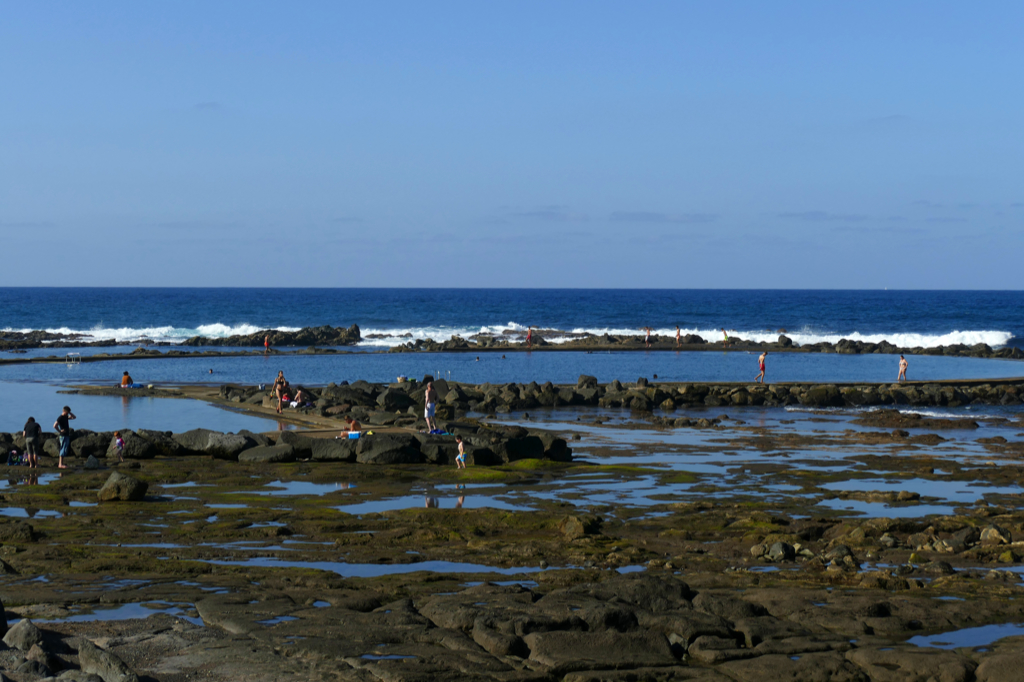
It’s a bit over 10 kilometers from Agüimes north of the coastal town of Arinaga. Here you find more beaches like for instance the Playa Balos and the Risco Verde natural pool. I’ve introduced these unique lava pools in my posts on Puerto de las Nieves and the city of Arucas.
How To Get There
Getting to Agüimes from Las Palmas is fast and easy. There are various connections where you have to change buses at Cruce de Arinaga. While this is not a big deal, it’s still better to take the direct bus #11. It starts at the Estación San Telmo and takes you to Agüimes in less than 45 minutes.
For more information and schedules, you can check out the website of Global, Gran Canaria’s interurban bus company.
Where To Stay
Agüimes is increasingly getting touristy. Obviously, we’re talking about slow tourism where travellers are keen on exploring the hinterland rather than mindlessly stewing on beaches. Therefore, you’ll find more small and authentic lodging options here. Notably charming are the old farmers’ and merchants’ mansions that were remodeled into guest houses. A particularly charming example is the Casa de los Camellos*, comfortable accommodation with lots of history.

Nevertheless, if the Casa de los Camellos* should be booked out, you’ll find other beautiful lodging options on this map*:
What To Eat
Agüimes has been the island’s main grain producer. Therefore, the town’s bakeries are arguably the best ones in all of Gran Canaria. And the local goat cheese has even won a number of prizes.

The restaurants offer mainly hearty traditional Canarian cuisine. If you’re not a vegetarian, you should definitely sample their cochino negro, black pork. But be warned: You’ll be lost for the regular kind of pork forever.
A very nice place to sample some exquisite tapas is the bar El Populacho on the northwest corner of the Plaza del Rosario. They are open from Wednesday to Monday from 10.30 a. m. till late, however, on Sundays and Mondays, they are closing already around 6 p. m.
Say It Right
Before the Spanish conquest, each Canary Island spoke its own type of the Guanche language. Due to the systematic pushback of the local culture by the Catholic conquerors, only fragments of the language exist to this date. You mostly find those traces in the names of places.
Today, the official language is Spanish, obviously. If you want to learn some basic Spanish or just brush up on your knowledge, there are various apps and online tools. I personally like to practice with babbel. However, due to international tourism, most people working in tourism and gastronomy speak at least some rudimentary English and very often also German.
Nevertheless, here are some ground rules for Spanish pronunciation since saying for instance city names wrong can cause some problems. If people don’t understand where you want to go, they won’t be able to give you directions.
It’s in the Mix
The good news is, that in general, you read Spanish the way it’s written. Only a couple of letters are a bit complicated.
Firstly, the letter C is a bit tricky for foreigners. Placed before an A, O, or U, it’s hard and pronounced as K. Followed by E or I, it is pronounced like an English the. Now, if you want that th-sound in combination with A, O, or U, the letter Z comes into the picture. So you have to pronounce Canaria Kanaria, and Plaza Platha.
On the other hand, if you want C to sound hard in combination with E or I, you make it a QU – but you don’t hear the U. Fine example: Tequila, which you pronounce like Tekkila.
This applies also to the letter G. If it’s followed by A, O, U, or a consonant, it’s pronounced like the G in guitar or Gran. To make a G sound hard before an E or an I, they squeeze in a silent U – like in guilt.
What’s With the Dots?
And here comes the spelling of Agüimes in the picture. Why are there those two dots on top of the U? Well, as I explained above, usually, a U after a G is silent and just makes the G pronounced hard. The two dots are telling you that this U is not silent. Hence, you pronounce the town’s name Agoo-eemes – with both, the U and the I pronounced separately and loud and clear. Another example of this is the Cuban city Camagüey which you pronounce Camagoo-ey.
However, if G stands before an E or an I, it is rather breathed than pronounced – a bit like the H in house.
The same applies to the letter J. You always pronounce it like the H in house.
The last trap is double L which is not pronounced like an L but like a Y in yellow. So a street is not Cale, but Caye. When a word is written with just one L like Tequila, it’s a simple and innocent L.
Map
This map should help you to find all the wonderful spots around Agüimes. Clicking on the slider symbol at the top left or the full-screen icon at the top right will display the whole map, including the legend.
Well-Organized Activities
Although I’m an avid solo-travelling woman, I sometimes like to join organized tours. Since I’m not driving, they are often a valid option to go to remote places. Also, it’s a great way to get in touch with fellow travellers. And finally, after my accident last year, I prefer not hiking in unknown areas by myself.
Therefore, here is a great opportunity to visit Santa Brígida and its surroundings on an organized tour…*:
…and here are some awesome day trips to other parts of Gran Canaria*:
Our day trips to Agüimes and Santa Brigida were only two of the many amazing tours during our week on the island of Gran Canaria. To read about the others, go to this post and take your pick!
For more information on travelling to Spain in general, go to the main post. There, you’ll find information and tips that will make your trip much smoother and more enjoyable.
Pinnable Pictures
If you choose to pin this post for later, please use one of these pictures:
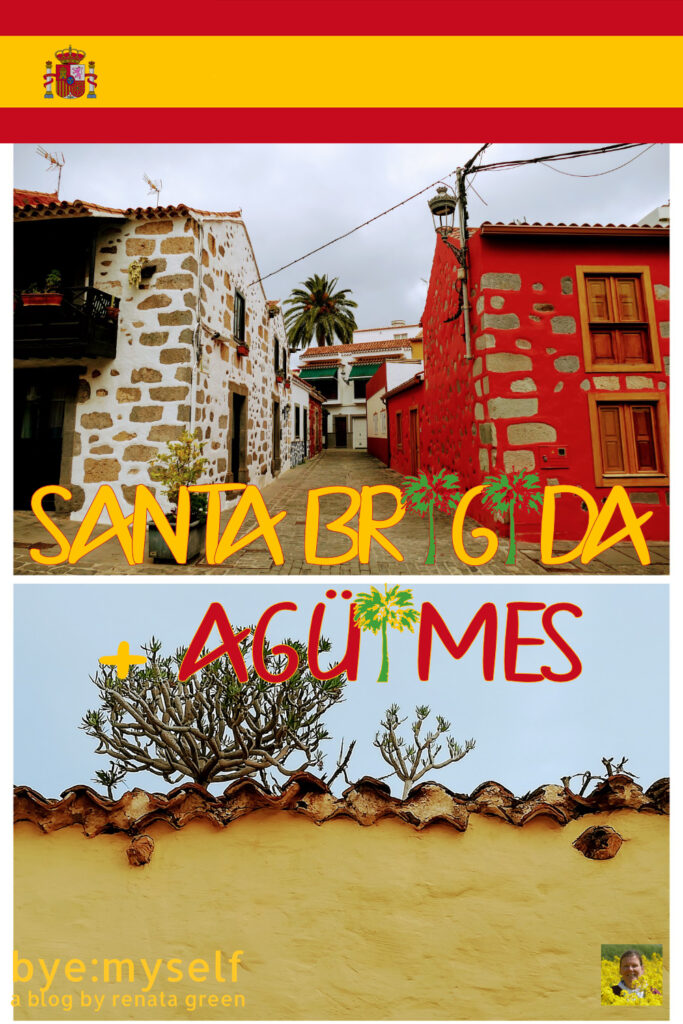


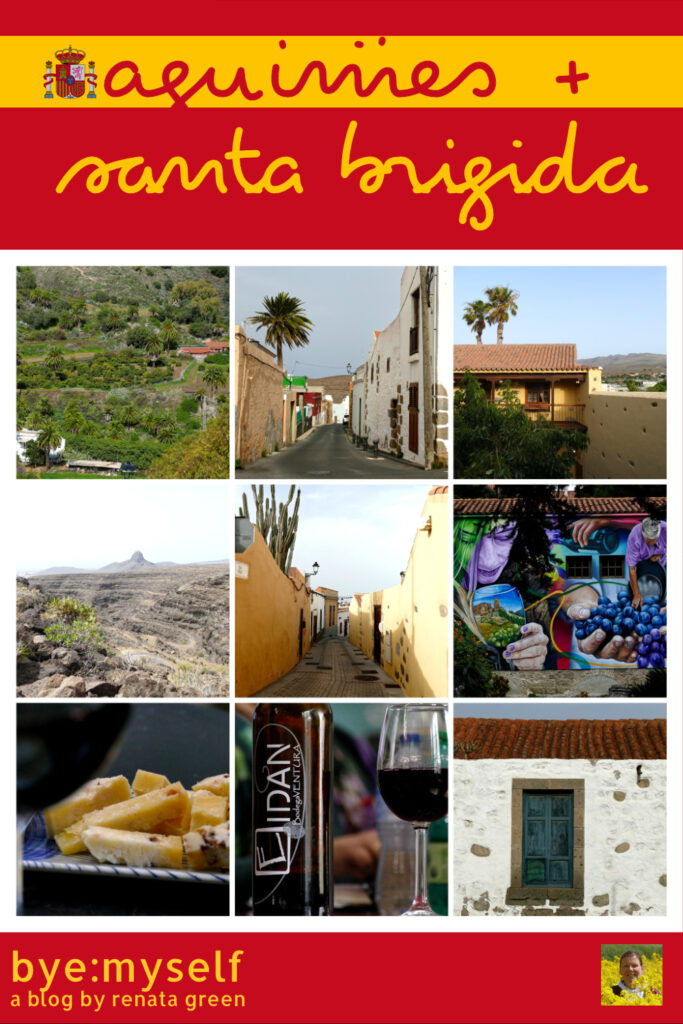

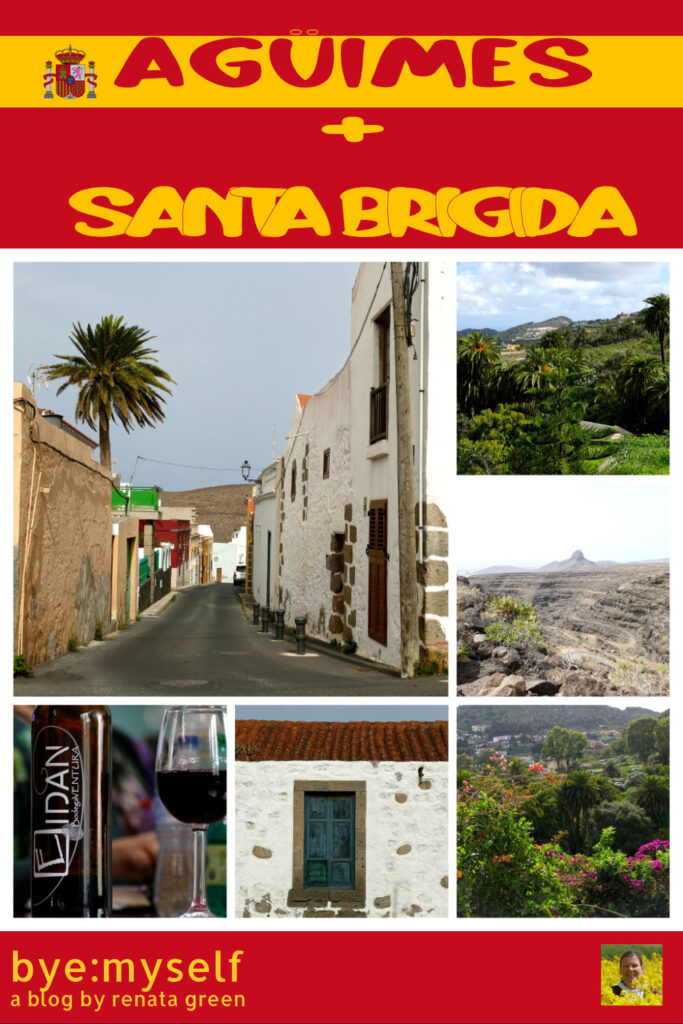
Note: I’m completing, editing, and updating this post regularly – last in October 2025.
Did You Enjoy This Post? Then You Might Like Also These:
EL MEDANO – where not only the wind will blow you away
Seven Days in BARCELONA And Ten Reasons Not to Miss Out on a Visit
MALLORCA – the best easy hikes
How to See the Highlights of LANZAROTE in Two Days
One Day in SANTA CRUZ de TENERIFE
Break a Leg – My Bumpy First Encounter With Gran Canaria
PALMA de MALLORCA – what to see in two days
Day Trip to San Cristobal de La Laguna and the National Park of Anaga
* This is an affiliate link. Hence, If you book through this page, not only do you get the best deal. I also get a small commission that helps me run this blog. Thank you so much for supporting me!


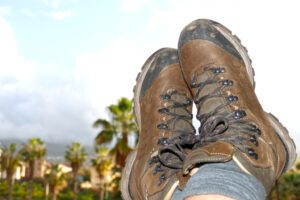


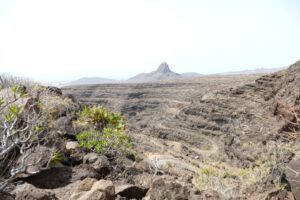

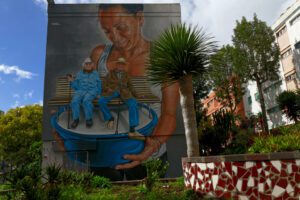
It’s a very inspiring article! I think I don’t have appreciated Gran Canaria so far. Even though I love Spain, I chose other regions apart from the islands. Now I know it’s time to change it. The Villages Agüimes and Santa Brigida are beautiful and have lovely nature. And this mural e Casa Museo del Vino – as a wine lover, I have to go there.
I think that’s the problem with most of the Spanish islands: They are looked down at as destinations for tacky mass tourism. The beautiful hinterland is totally neglected.
It looks like the city and the architect planned to paint the old architecture in Santa Brigida to attract tourists. I wonder if the city paid for the paints. Personally, I think Aguimes looks more interesting than Santa Brigida.
Hahaha – to each their own, right?!? But as a matter of fact, Agüimes is my personal favorite when it comes to villages in Gran Canaria 😉
We are planning a 2 week trip – one week in Gran Canaria and the other in Tenerife and will hike most days. Usually between 2-4 hours. In Gran Canaria, I want to stay 3-4 nights in Tejeda and have 3 nights for elsewhere. I am torn between Sant Brigida, Artenara, or Puerto de las Nieves or las Palmas. We are 65 and in good shape and like good food too. Scenery that will be a bit different than Tejeda.Help please. Any thoughts? Thank you
Artenara is very isolated – but you can actually hike there from Tejeda. For hiking, I would opt for Santa Brigida – many great hiking opportunities around and the sceneries are ‘softer’ than Tejeda and Artenara. Also, they have a very reliable bus system in Gran Canaria, hence, you can visit for instance Puerto de las Nieves or Las Palmas on a day trip. Hope this helps. Anyhow, I wish you a fantastic trip!
The place looks so beautiful and serene, looks like a perfect day trip.
Yes, the sceneries are magic 🙂
Looks like a great day trip! Grand Canaria is an island I skipped, now I wanna see it so bad! Donkey belly must have been hell of the experience. Wine museum sounds fun as well, I can totally see my sister there.
It’s actually quite underrated since most visitors just come for the beaches 🙂
Of course, my favorite is the wine museum next to the bus stop! But I love the quaint old roads as well. They always seem like you could discover a hidden treasure or a mystery around every corner.
Yes, a good wine is definitely part of the culture 🙂
This place looks amazing, I will note it. Hopefully, I can travel and check out this amazing place.
You are helping me to build a long list of places we have to visit the next time we get to Gran Canaria. I love the idea of getting into the countryside at Santa Brigida and hiking to the caldera. Everything looks so lush. And the tiny town of Aguimes looks so charming. I might spend some time on that bench with the statues! That view of the Barranco de las Vacas made me think you had moved to the red rocks of Utah! Some great stops on your day trip.
Yes, far too many visitors miss out on Gran Canaria’s hinterland – which is at least as nice as the coasts 🙂
Thanks so much for this detailed day trip sharing, love it especially with what to eat recommendations, done saved it as my trip reference. Cheers Sienny
Glad you like it 🙂
So beautiful!
I found it so interesting to learn about “donkeys belly” too. Crazy experience!
Yap, I experienced the belly to its max 😀